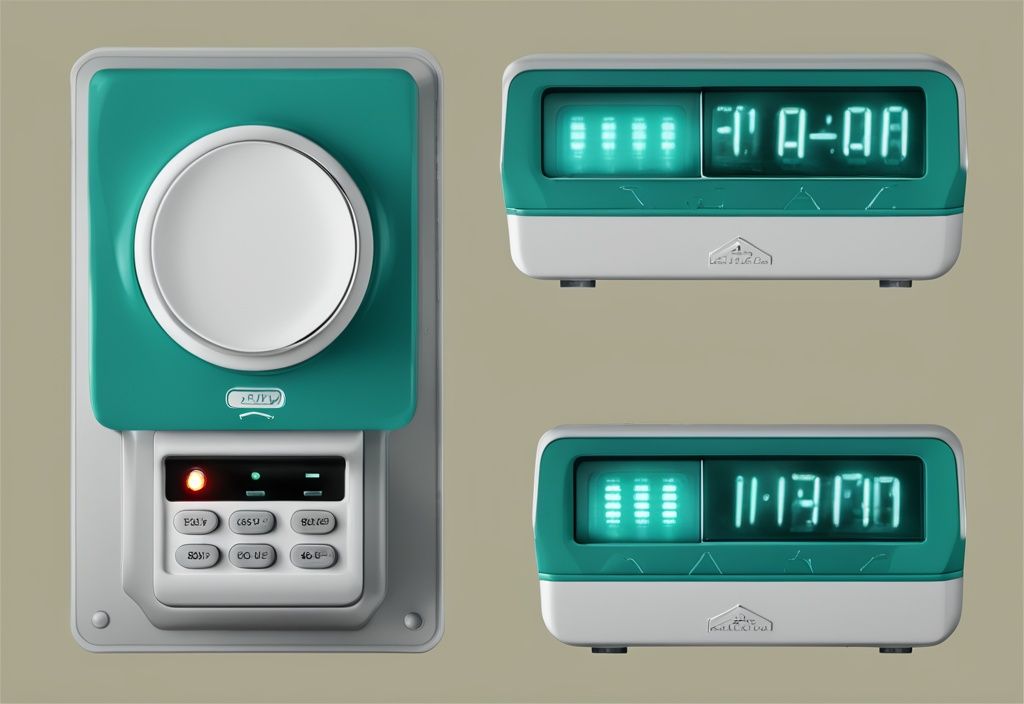Passive vs Non Passive Alarm: An In-Depth Guide
Did you know that a car is stolen every 44 seconds in the US? It’s a startling fact, isn’t it? And it highlights the importance of a robust car alarm system. So, let’s talk about passive vs non-passive alarms – the two main types of car alarm systems out there.
In this guide, we’ll delve into the nitty-gritty of both systems, shedding light on their pros and cons, how they operate, and their impact on your insurance premiums. This isn’t just about facts and figures, but about helping you make a decision that suits your lifestyle and gives you peace of mind.
So, ready to figure out which alarm system is your car’s best friend? Let’s dive right in!
Understanding Passive and Non-Passive Alarms
When it comes to vehicle security, understanding the differences between passive and non-passive alarms can help you make an informed decision. Both systems offer unique benefits and drawbacks, and knowing how they work can ensure you choose the right protection for your needs.
What are Passive Alarms?
A passive alarm system is a type of security system that automatically arms itself when the vehicle is turned off, the ignition key is removed, or a door is shut. These systems are designed to provide security without requiring any action from the driver.
Passive alarms typically include features such as ignition kill switches and triggering alarms when unauthorized access is detected, like opening doors, the trunk, or the hood without the key. This automatic activation makes them highly convenient for users, as the system arms itself without needing manual intervention.
How do Passive Alarms Work?
Passive alarms operate by turning on automatically when certain conditions are met, such as the key being removed from the ignition and all doors being closed. This process is seamless and requires no action from the driver, hence the term “passive.”
Once activated, passive alarms provide continuous protection. They remain armed at all times, significantly reducing the risk of theft by ensuring the vehicle is always protected, even if the driver forgets to manually engage the security system.
Pros and Cons of Passive Alarms
- Pros: Automatic arming eliminates the risk of forgetting to activate the system, ensuring better overall protection. Because passive alarms are always armed, they may also result in lower insurance rates due to their constant protection.
- Cons: These alarms can sometimes be accidentally set off by the owner when re-entering the vehicle. Additionally, if not properly installed or if the vehicle is not used regularly, passive alarms can drain the vehicle’s battery. They may also activate too early, requiring the driver to disengage the alarm during multiple trips to the car.
What are Non-Passive Alarms?
Non-passive alarms, also known as active alarms, require the user to manually arm and disarm the system, typically by pressing a button on a remote control. This type of alarm system gives the driver more control over the security of their vehicle.
Active alarms often come with additional features such as panic buttons, two-way remotes that alert the user when the alarm is triggered, and even GPS tracking. The driver plays an active role in managing the alarm, which is why it is termed “active.”
How do Non-Passive Alarms Work?
To activate a non-passive alarm, the driver must manually arm the system, usually by pressing a button on a remote control. This manual activation allows the driver to decide when the alarm should be armed, offering more convenience in various situations.

Active alarms provide flexibility, as they allow the driver to make multiple trips to and from the vehicle without setting off the alarm. This feature is particularly beneficial in scenarios where the driver needs to access the vehicle multiple times within a short period.
Pros and Cons of Non-Passive Alarms
- Pros: Active alarms prevent accidental set-offs since the driver controls when it is armed. They offer more features than passive alarms, such as remote starting and remote keyless entry. Additionally, they provide more control over the system, allowing the driver to choose when to arm or disarm it.
- Cons: The primary drawback is that the driver must remember to arm the system, which can sometimes be forgotten. Moreover, active alarms can be more easily disarmed by thieves with the right tools or knowledge. Insurance discounts for non-passive alarms are generally modest compared to passive alarms.
Comparing Passive and Non-Passive Alarms
Passive and non-passive alarms offer distinct advantages and cater to different user preferences. In terms of convenience, passive alarms stand out as they automatically arm when the vehicle is turned off, the ignition key is removed, or a door is shut. This automatic activation means the driver doesn’t have to remember to arm the system, providing seamless protection without any manual intervention.
On the other hand, non-passive alarms require the driver to manually activate them, usually by pressing a button on a remote control. This offers a higher level of control, allowing the driver to decide exactly when to arm the system. For those who prefer having command over their vehicle’s security, non-passive alarms are ideal.
However, the risk of forgetting to arm the system is a significant drawback of non-passive alarms. Passive alarms eliminate this risk entirely, ensuring the vehicle is always protected without any action required from the driver.
Passive vs Non-Passive: A Battle for Control and Convenience
Passive alarms are like having a vigilant guard who never sleeps. They arm automatically when you turn off the vehicle, remove the ignition key, or shut a door. No need to remember to press a button—it’s all done for you. This means your car is always protected, even if you’re forgetful.
Non-passive alarms, on the other hand, put you in the driver’s seat. You decide when to arm the system, usually with a press of a button on a remote. This gives you more control, which some people prefer. But, there’s a catch.
For enhanced security, consider implementing an access control system to manage permissions effectively. If you forget to activate it, your car is left vulnerable.
So, if you value convenience and peace of mind, passive alarms are the way to go. If you prefer control and don’t mind the extra step, non-passive alarms might be your choice.
Which Alarm System Offers Better Protection?
When it comes to continuous protection, passive alarms have a clear advantage. These systems are always armed, providing constant security against potential theft or unauthorized access. This uninterrupted protection reduces the likelihood of a security lapse, making passive alarms a reliable choice for continuous vehicle safety.
Non-passive alarms, while offering flexibility and control, can be more easily disarmed if the driver forgets to activate them. This human error introduces a vulnerability that can be exploited by thieves. Therefore, in terms of consistent security, passive alarms tend to offer better protection. If you’re concerned about vehicle theft, you might want to learn how to track your car if it gets stolen. Nevertheless, both types of alarms have their own operational methods and potential drawbacks. The choice between the two often depends on the user’s lifestyle and how they prefer to balance convenience and control.

Insurance Benefits: Passive vs Non-Passive
Insurance companies often favor vehicles equipped with passive alarms due to their constant protection, which can lead to lower insurance rates. The continuous arming of passive alarms reduces the risk of theft, making them a preferred choice for insurers looking to minimize claims.
In contrast, the discounts offered for non-passive alarms are generally more modest. While these systems do enhance vehicle security, the potential for human error in forgetting to arm the alarm makes them slightly less reliable in the eyes of insurance providers.
Regardless of the type of alarm system chosen, professional installation is typically required by insurance companies to qualify for any premium discounts. This ensures that the system is set up correctly and functions as intended, providing the expected level of security.
Choosing Between Passive and Non-Passive Alarms
When deciding between a passive vs non-passive alarm, the choice largely hinges on the driver’s preference for convenience versus control. Passive alarms offer the convenience of automatic activation, ensuring the vehicle is always protected without the need for manual intervention. This is particularly beneficial for those who value ease of use and tend to forget to arm their alarm system. On the other hand, non-passive alarms provide greater control, as the driver can decide when to arm or disarm the system, which can be advantageous in various situations.
How to Choose the Right Alarm System for Your Car
Another critical aspect to consider is the vehicle’s security needs. If the vehicle is parked in high-risk areas or frequently left unattended, a passive alarm might offer better protection due to its constant arming. However, if the driver prefers more advanced features like remote start or keyless entry, a non-passive alarm might be more suitable.
Regardless of the type chosen, professional installation is crucial. A properly installed alarm system ensures optimal functionality and reliability, reducing the risk of false alarms and potential battery drain. Professional installation may also be required to qualify for insurance discounts.
Vehicle Usage Patterns and Their Impact on Alarm Choice
Understanding your vehicle usage patterns is essential when choosing between a passive vs non-passive alarm system. For instance, if you frequently make multiple trips to and from your vehicle, a non-passive alarm can be more convenient. It allows you to arm the system only when necessary, preventing accidental triggers.
For vehicles that are used regularly, passive alarms provide continuous protection, automatically arming whenever the vehicle is turned off, the ignition key is removed, or a door is shut. This constant protection is ideal for daily drivers who want seamless security without the need for manual activation.
However, if the vehicle is not used frequently, a passive alarm might drain the battery over time. In such cases, a non-passive alarm, which only activates when manually armed, could be a better option to prevent unnecessary battery consumption.
Insurance Discounts and Alarm Systems: What You Need to Know
When evaluating the benefits of a passive vs non-passive alarm for insurance purposes, it’s important to check with your provider. Some insurance companies offer discounts for vehicles equipped with alarm systems, particularly passive alarms, due to their constant protection. Such discounts can result in lower insurance premiums, making passive alarms an attractive option for cost-conscious drivers.
However, it’s crucial to remember that an alarm system should not replace comprehensive insurance coverage. While alarms can deter theft and provide peace of mind, comprehensive coverage offers broader protection against various risks, including accidents and natural disasters.

Moreover, professional installation of the alarm system is often a requirement for qualifying for insurance discounts. Ensuring that the alarm is correctly installed by a professional not only maximizes its effectiveness but also meets the criteria set by most insurance providers.
FAQs on Passive vs Non-Passive Alarms
What is the Main Difference Between Passive and Non-Passive Alarms?
The main difference between passive and non-passive alarms lies in their activation method. Passive alarms automatically arm themselves when the vehicle is turned off, the ignition key is removed, or a door is shut. This automatic feature ensures constant protection without any action required from the driver. In contrast, non-passive alarms require the user to manually arm and disarm the system, typically by pressing a button on a remote control. This manual activation offers the driver more control over when the alarm is armed but also introduces the risk of forgetting to activate the system.
Can I Switch Between Passive and Non-Passive Modes?
Yes, most modern alarm systems offer the flexibility to switch between passive and non-passive modes. This allows users to choose the mode that best fits their current needs. The transition between modes can often be done by the driver themselves through the alarm system settings. However, for those who prefer a professional touch, a technician can also handle the switching process. This adaptability makes it easier for drivers to balance convenience and control based on their daily routines.
Do Insurance Companies Offer Discounts for Both Types of Alarms?
Insurance companies often provide lower rates for vehicles equipped with passive alarms due to their constant protection. This continuous security feature reduces the risk of theft, which is favorable for insurance providers. On the other hand, discounts for non-passive alarms tend to be more modest. While they still offer protection, the manual activation aspect means there’s a higher chance the system might not be armed. Additionally, insurance companies may require professional installation of the alarm system to qualify for any premium discount, ensuring that the system is correctly set up and fully operational.
Conclusion
Summary
Both passive and non-passive alarms offer valuable protection for your vehicle, but the best choice hinges on your needs and habits. Passive alarms activate automatically, ensuring the system is always armed without any effort from you. Non-passive alarms, however, give you greater control, letting you decide when to arm or disarm the system. Understanding these differences can help you make an informed decision that best suits your lifestyle and security requirements.
Convenience vs Control
When comparing passive vs non-passive alarms, the primary distinction lies in the balance between convenience and control. Passive alarms automatically arm themselves when the vehicle is turned off, providing seamless and continuous protection without requiring any action from you. This feature eliminates the risk of forgetting to activate the alarm, which can be a significant advantage for those who prefer a hassle-free security solution.
Conversely, non-passive alarms necessitate manual activation, giving you the flexibility to arm and disarm the system as needed. This can be beneficial in scenarios where frequent access to the vehicle is necessary, such as during multiple trips for loading and unloading.
Professional Installation
Regardless of whether you choose a passive or a non-passive alarm, professional installation is highly recommended. Proper installation ensures that the alarm system functions correctly and integrates seamlessly with your vehicle’s existing electrical system. A professionally installed alarm system is less likely to experience issues such as false alarms or battery drain, which are common problems when alarms are not set up correctly.
Moreover, professional installation may be a requirement for qualifying for insurance discounts, adding an extra layer of security and peace of mind.
Insurance Benefits
Having an alarm system installed in your vehicle can lead to insurance benefits, but it’s important to understand the nuances between passive vs non-passive alarms. Insurance companies often offer lower rates for vehicles equipped with passive alarms due to their constant protection. These systems are perceived as providing a higher level of security, which can translate to reduced risk for the insurer.
Non-passive alarms, while still beneficial, typically result in more modest insurance discounts. It’s essential to consult with your insurance provider to understand the specific discounts available and any requirements, such as professional installation, to qualify for these benefits. However, it’s crucial to remember that an alarm system should complement, not replace, comprehensive insurance coverage.
I’m James Albright, a home security expert with over 15 years of experience, and I’m passionate about helping families protect what matters most. After serving as a police officer, I transitioned to security consulting to share my hands-on knowledge and practical tips. My mission is to make home security simple and reliable by offering clear, no-nonsense advice and easy-to-follow guides. When I’m not reviewing the latest security tech or writing, I’m out in the community leading neighborhood watch programs and, most importantly, keeping my own family safe.





Post Comment